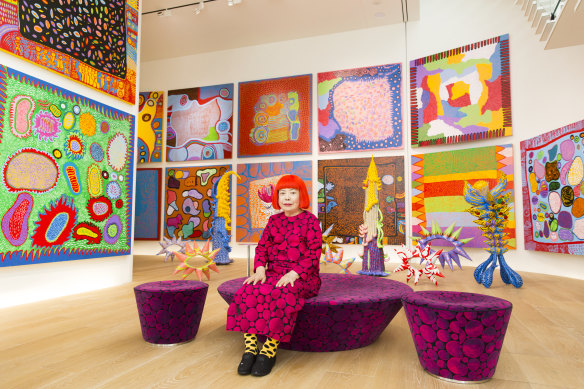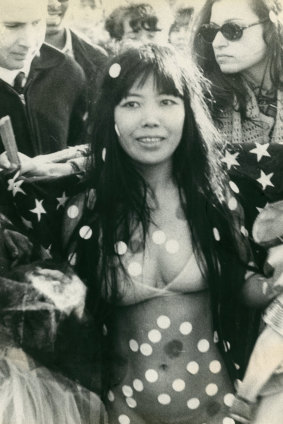
You’ll be familiar with the polka dots. Scattered over outsized pumpkins, crowding the walls of hallucinatory mirrored rooms, or splashed across Louis Vuitton bags, this playful motif is as synonymous to Yayoi Kusama as the soup can is to Andy Warhol. At a new exhibition opening in summer at the NGV, these dots will take over the entire ground floor of the gallery, in the most comprehensive survey of Kusama’s work ever to be brought to Australia.
“Everyone is familiar with Kusama – she’s become part of a global visual vernacular,” says Wayne Crothers, the NGV’s senior curator of Asian art. But what this exhibition offers is the opportunity to discover the astonishing breadth and hypnotic consistency of the 95-year-old artist’s practice.

Yayoi Kusama with her recent works in Tokyo, 2016.Credit: Yayoi Kusama
Rather than bringing a ready-made exhibition to Australian shores, the curators have pulled work from an array of smaller museums and private collections – including the artist’s own archives – to build a one-of-a-kind show from the ground up. “The travelling shows often borrow from institutions in the US or in Europe, but we’ve focused on borrowing from a lot of Japanese institutions that don’t often lend work,” explains Crothers.
This approach has allowed the curators to bring together rarities like gestural, brush and ink paintings from Kusama’s early career in Japan, a series of avant-garde portraits of famous women like Marilyn Monroe and Mata Hari from the 1970s, and a collection of wearable art from her little known clothing line, seen in its entirety.
Childhood sketchbooks and archival photographs of her family’s rural farm highlight her early years, while catalogues, handbills, videos and slideshows illuminate her practice in mid-century New York, where she began to develop many of the artistic concepts she is renowned for today.

Yayoi Kusama at Bust Out Happening 1969, Sheep Meadow in Central Park, New York.Credit: Yayoi Kusama
In spite of her outsider status as both a woman and an immigrant in New York’s art scene, Kusama became central to what curator and Yayoi Kusama exhibition catalogue-contributor Marie Laurberg calls “an explosion of artistic creativity”.
“Kusama came to New York at a time when there was a huge paradigm shift in the art world,” Laurberg explains. “You saw a new generation of artists challenging the whole notion of the art concept. Art was fused with everyday life, with pop culture; completely new formats like performance and happenings emerged, and Kusama was an integrated part of that movement. She was part of shaping what pop art looked like, at the time.”
“Kusama’s art is very expressive,” she continues. “I see her as an expressionist pop artist because a lot of pop art is very surface-oriented – it’s interested in consumer products, in market culture. Kusama’s art always comes from her own imagination, but she is a pop artist in that she disseminates her work in a very pop-like way.”









 Add Category
Add Category